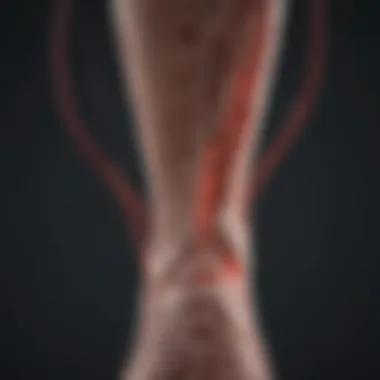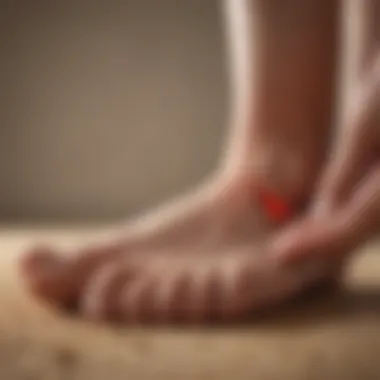Understanding Non-Diabetic Neuropathy Foot Pain


Intro
Non-diabetic neuropathy foot pain is a complex condition that affects various individuals, significantly impacting their daily lives. While diabetes-related neuropathy often garners more attention, non-diabetic forms deserve recognition and understanding. This article aims to dissect this condition, examining its causes, symptoms, and treatment options while highlighting the importance of lifestyle choices in managing the pain.
Research Context
Background Information
Neuropathy refers to a range of disorders that result from damage to the nerves, causing pain, weakness, or numbness. Non-diabetic neuropathy encompasses several types, including idiopathic neuropathy, hereditary neuropathy, and neuropathies associated with other medical conditions, such as autoimmune diseases or infections. Foot pain is commonly reported among individuals suffering from these neuropathies, often affecting mobility and overall quality of life.
Importance of the Study
Understanding the intricacies of non-diabetic neuropathy foot pain is crucial as it impacts numerous people who may not receive appropriate diagnosis or treatment. Many of these individuals suffer silently, with their condition frequently overlooked by the medical community. By investigating this subject, we aim to shed light on the underlying causes and patterns of symptoms. This study also explores holistic treatment options, thus providing comprehensive support to those affected.
Discussion
Interpretation of Results
Through diverse research methodologies and patient narratives, we can gather insights into non-diabetic neuropathy. Symptoms often emerge gradually, starting with tingling sensations or minor discomfort before progressing to more severe pain or even functional impairment. Individuals may describe feelings of burning or stabbing pain. Understanding these nuanced symptoms can help facilitate earlier diagnosis and intervention.
Comparison with Previous Research
Previous studies have primarily focused on diabetic neuropathy, leaving a gap in literature on non-diabetic forms. The relevance of this research lies in addressing these gaps, providing a broader perspective on how neuropathy can manifest independently of diabetes. By comparing symptomatology, diagnostic techniques, and treatment responses, this exploration enhances our understanding of neuropathy as a whole.
Overall, the exploration of non-diabetic neuropathy is vital for enhancing diagnostic accuracy and creating more effective treatment plans. A more profound comprehension of this condition will help not only patients but also professionals who deal with such cases.
Intro to Non-Diabetic Neuropathy
Understanding non-diabetic neuropathy is essential due to its substantial impact on individuals who suffer from it. Unlike diabetic neuropathy, non-diabetic neuropathy can stem from various other causes and affect multiple systems in the body. This topic not only highlights the emerging importance of recognizing different neuropathies but also informs on effective management strategies that help ameliorate foot pain. In an age where awareness of neurological disorders is increasing, it is critical to deepen our grasp of non-diabetic neuropathy to enhance patient care.
Neuropathy itself designates a malfunction or injury to nerves, leading to symptoms such as pain, numbness, and weakness. Focusing on non-diabetic neuropathy allows for a comprehensive evaluation of why and how these conditions arise and their management. This section will navigate the foundational aspects of the condition, ultimately paving the way for a deeper dive into its various manifestations.
By illustrating the nuances of this condition, individuals suffering from non-diabetic neuropathy can better articulate their experiences and seek informed solutions. Furthermore, understanding the condition promotes dialogue between healthcare providers and patients, fostering shared decision-making and improved treatment outcomes.
"Awareness of non-diabetic neuropathy can significantly enhance the quality of life for many individuals who feel overlooked."
This introduction sets the stage for a thorough exploration into the causes, symptoms, and treatments of non-diabetic neuropathy foot pain, empowering both sufferers and healthcare professionals alike.
Types of Non-Diabetic Neuropathy
Understanding the types of non-diabetic neuropathy is essential for comprehending the specific manifestations and pathophysiology of each variant. This knowledge enables healthcare professionals to tailor their diagnostic and therapeutic approaches. Additionally, recognizing the symptoms associated with each type can aid patients in articulating their experiences clearly, leading to more effective management of their conditions. Non-diabetic neuropathy can be broadly classified into three main types: peripheral neuropathy, autonomic neuropathy, and focal neuropathy.
Peripheral Neuropathy
Peripheral neuropathy affects the peripheral nerves, which are responsible for transmitting information between the brain, spinal cord and the rest of the body. This form of neuropathy can cause a variety of symptoms, including tingling, numbness, and pain in the extremities. Importantly, peripheral neuropathy can arise from various causes unrelated to diabetes, such as infections, physical injuries, or exposure to toxins.
Patients with peripheral neuropathy may have difficulty in performing daily activities due to sensory and motor dysfunction. The impairment often leads to a lack of balance, which can increase the risk of falls. This highlights the importance of early diagnosis and potential interventions, as untreated peripheral neuropathy can further deteriorate one's quality of life.
Autonomic Neuropathy
Autonomic neuropathy impacts the autonomic nervous system, which regulates involuntary bodily functions. This includes heart rate, blood pressure, digestion, and bladder control. Individuals with this type of neuropathy may experience symptoms like orthostatic hypotension, digestive issues, or sexual dysfunction.
The diagnosis of autonomic neuropathy can be particularly challenging due to the non-specific nature of its symptoms. This makes it vital for patients to communicate any irregularities in bodily functions to their healthcare providers. Understanding the potential implications of this condition is crucial as mismanagement can lead to serious complications, including cardiovascular issues.
Focal Neuropathy
Focal neuropathy, also known as mononeuropathy, involves damage to a single nerve or a specific group of nerves. Symptoms can vary widely based on the nerve affected. Common instances include carpal tunnel syndrome and Bell's palsy.
This type of neuropathy can develop suddenly and may cause pain, weakness, or dysfunction in the affected area. The prognosis is often favorable, with many patients experiencing a complete resolution of symptoms following appropriate treatment. Thus, timely recognition and management play a significant role in the recovery process.
Understanding the specific types of non-diabetic neuropathy lays the groundwork for effective clinical evaluation and management strategies.
Causes of Non-Diabetic Neuropathy Foot Pain


Understanding the causes of non-diabetic neuropathy foot pain is crucial for those affected by this condition. Identifying the root cause helps in the development of effective treatment plans. Non-diabetic neuropathy can stem from various factors, and recognizing these is the first step in managing pain and improving quality of life. Knowledge of the causes also aids in prevention, allowing individuals to make informed lifestyle choices.
Genetic Factors
Genetic predisposition plays a significant role in the development of non-diabetic neuropathy. Certain inherited conditions can make individuals more susceptible to nerve damage. For instance, hereditary neuropathy with liability to pressure palsies is a genetic disorder that affects peripheral nerves and can result in pain and weakness. Understanding one’s family medical history is important, as it can provide insight into potential risks and guide proactive measures for nerve health.
Infections and Autoimmune Disorders
Infections can trigger neuropathy as well. Certain viral and bacterial infections may lead to inflammation of the nerves, resulting in pain and discomfort. Examples include Lyme disease, HIV, and shingles.
Autoimmune disorders also contribute to neuropathy. In these cases, the immune system mistakenly attacks healthy nerve tissue. Conditions such as lupus and rheumatoid arthritis can lead to nerve damage, causing pain in various areas of the body including the feet. Recognizing the interplay between infections, autoimmune disorders, and neuropathy is vital for effective diagnosis and treatment.
Toxic Exposure
Exposure to toxins is another significant cause of neuropathy. Many substances can have damaging effects on the nervous system, including heavy metals, solvents, and certain medications. For instance, chemotherapy drugs are known to cause neuropathy as a side effect. Environmental toxins may also be responsible and can accumulate in the body over time, leading to gradual nerve impairment.
It’s essential to minimize exposure to known neurotoxins. This includes assessing workplace environments and avoiding harmful substances in daily life. Awareness can help individuals take steps to reduce risks associated with toxic exposure.
Nutritional Deficiencies
Nutritional deficiencies can also result in neuropathy. Vitamins such as B12 play a critical role in maintaining nerve health. A deficiency in such nutrients can lead to nerve damage and associated pain. Many individuals may not realize their dietary habits can significantly influence their nervous system health. A well-balanced diet rich in fruits, vegetables, whole grains, and lean proteins is key to preventing deficiencies.
Symptoms of Non-Diabetic Neuropathy Foot Pain
Understanding the symptoms of non-diabetic neuropathy foot pain is crucial for both patients and healthcare professionals. Recognizing these symptoms early can lead to more effective management and potentially improve overall quality of life. This section will detail significant symptoms, helping readers identify the condition in themselves or others. Many individuals may dismiss their pain as minor discomfort. However, these symptoms can be essential indicators of underlying neuropathy. By paying attention to these early signs, one can seek timely help and avoid complications.
Tingling and Numbness
Tingling and numbness are among the first symptoms many individuals report. These sensations might feel like pins and needles or a loss of sensation. Tingling often occurs in the toes or feet, which can be alarming for those experiencing it. This symptom is related to nerve damage, where the ability of nerves to send signals to the brain becomes compromised. Understanding this connection can help patients grasp the seriousness of their symptoms.
- Sensation levels: Tingling can occur intermittently or be persistent. It's essential to monitor how frequently these sensations occur.
- Physical effects: With time, numbness can increase in intensity, possibly affecting daily activities, such as walking or standing.
- Causes: These sensations often arise from damaged or malfunctioning nerve pathways, which can lead to a reduced quality of life.
Sharp or Burning Pain
Another common symptom is sharp or burning pain. This type of pain can be particularly distressing. It might feel like a sudden jolt or an ongoing burning sensation. For many, this pain can be exacerbated during the night or while at rest. The psychological impact of enduring such discomfort should not be overlooked.
- Variability: The intensity can vary widely from one individual to another. Some may experience mild discomfort, while others face debilitating pain.
- Triggers: Various stimuli, such as temperature changes or physical pressure, often intensify this pain. One’s environment can play a crucial role in how symptoms manifest.
- Management difficulties: Sharp pain can complicate mobility, resulting in avoidance behavior, which may further weaken muscle strength.
Weakness in the Foot
Foot weakness represents another significant symptom of non-diabetic neuropathy. It can manifest as a decreased ability to perform routine tasks like walking or climbing stairs. When individuals notice weakness, it can stir concerns about balance and stability. As a result, they may limit their physical activities, contributing to a sedentary lifestyle.
- Impact on mobility: Reduced strength can lead to difficulties in moving the foot properly. This may cause slippage, resulting in injuries or falls.
- Long-term consequences: Over time, weakness may lead to muscle atrophy, further complicating recovery and treatment efforts.
- Assessment: Carrying out physical evaluations can help gauge the extent of weakness in the foot.
"Identifying symptoms early in non-diabetic neuropathy foot pain can significantly influence treatment outcomes."
Diagnosis of Non-Diabetic Neuropathy
Diagnosing non-diabetic neuropathy is a critical step in understanding the underlying issues causing foot pain. Proper diagnosis not only helps identify the specific type of neuropathy but also guides the treatment plan. Recognizing the symptoms early can significantly improve quality of life. This section addresses the importance of accurate diagnosis using a multifaceted approach, which includes clinical evaluation, specialized tests, and analyzing blood results. The benefits of proper diagnosis extend beyond symptom relief; they can enhance overall patient management by providing a clearer picture of the condition and potentially revealing associated health problems.
Clinical Evaluation
A comprehensive clinical evaluation is the first step in diagnosing non-diabetic neuropathy. This process typically begins with a detailed medical history and a discussion of symptoms with a healthcare provider. Symptoms can vary widely among individuals, making it essential for the clinician to understand the specific details, such as the onset, duration, and nature of the pain.
During the evaluation, the clinician may perform a physical examination to assess the patient's neurological function. This includes testing sensation and reflexes in the feet. Observing any changes in muscle strength or coordination is also crucial. The information gathered during this evaluation can aid in formulating a preliminary diagnosis and determining if further testing is necessary. Clinicians may aim to rule out other potential causes of pain, including vascular issues or musculoskeletal injuries. Therefore, a thorough clinical evaluation lays the groundwork for an accurate diagnosis.
Electromyography and Nerve Conduction Studies
Electromyography (EMG) and nerve conduction studies (NCS) are diagnostic tests that provide essential information regarding nerve and muscle function. These tests help to confirm or exclude the presence of nerve damage that characterizes neuropathy.
Electromyography measures the electrical activity of muscles at rest and during contraction. By inserting a thin needle electrode into specific muscles, clinicians can observe abnormal electrical activity that may indicate neuropathy.
Nerve conduction studies examine how electrical signals travel through nerves. Small electrodes are placed on the skin over the tested nerves, allowing for measurement of conduction velocity. Slow conduction can indicate nerve damage or dysfunction. These tests are vital; they provide quantitative data that can help differentiate between various types of neuropathy. The results can enhance treatment decisions and offer insight into the severity of the condition.


Blood Tests
Blood tests can reveal important information that may assist in diagnosing non-diabetic neuropathy. They can identify underlying issues, such as nutrient deficiencies, autoimmune disorders, or inflammatory conditions that could contribute to nerve damage. Common tests may include:
- Complete blood count (CBC)
- Comprehensive metabolic panel (CMP)
- Vitamin levels, especially B12 and folate
- Thyroid function tests
Through blood testing, clinicians may also discover systemic conditions affecting nerve health. Such findings can direct further investigation and treatment options tailored to the individual. Close attention to these details stands as an integral part of the diagnostic process for non-diabetic neuropathy.
Accurate diagnosis of non-diabetic neuropathy enables targeted treatment approaches, enhancing the overall management of foot pain.
Understanding these diagnostic tools and procedures is essential in managing non-diabetic neuropathy. By recognizing the symptoms early and utilizing specific tests, patients and clinicians can work together to create a detailed and effective treatment plan.
Impact of Lifestyle Choices
The influence of lifestyle choices on non-diabetic neuropathy foot pain is substantial. It encompasses various aspects such as diet, exercise, and substance use. Understanding these factors is critical for managing and possibly alleviating the symptoms associated with neuropathy. By adopting healthier habits, individuals may experience improved quality of life. Therefore, exploring this topic is not only relevant but imperative for those affected.
Diet and Nutritional Intake
The role of diet in managing non-diabetic neuropathy cannot be overstated. Nutritional intake directly impacts nerve health and overall well-being. A balanced diet rich in vitamins and minerals can support nerve function. Nutritional deficiencies, particularly of Vitamin B12, Vitamin D, and magnesium, may worsen neuropathic symptoms. Incorporating whole foods like fruits, vegetables, whole grains, lean proteins, and healthy fats can have a positive effect.
- Key nutrients to consider:
- Vitamin B12: Important for nerve health.
- Omega-3 fatty acids: Found in fish, these can reduce inflammation.
- Antioxidants: Such as Vitamin C and E, which help reduce oxidative stress on the nerves.
It is essential to avoid excessive consumption of processed foods high in sugar and unhealthy fats. These can lead to weight gain, which may put additional pressure on the feet and exacerbate discomfort. Making informed dietary choices can be a significant strategy in the management of foot pain associated with neuropathy.
Physical Activity and Exercise
Engaging in regular physical activity is another critical aspect of lifestyle choices. Exercise improves blood circulation, which is vital for nerve health. It can also help maintain a healthy weight, reducing stress on the feet. Activities tailored to individual capabilities, such as walking, swimming, or low-impact aerobics, may be beneficial.
- The benefits of physical activity include:
- Improved blood flow to the lower extremities.
- Pain relief through the release of endorphins.
- Strengthened muscles supporting the foot and ankle.
However, it is essential to approach exercise cautiously. Individuals with neuropathy may have balance issues or foot sensitivity. Consulting a healthcare professional before starting any new exercise regimen is advisable for safety and effectiveness.
Substance Use
The impact of substance use, including alcohol and tobacco, on non-diabetic neuropathy is noteworthy. Excessive alcohol consumption can lead to nerve damage, exacerbating neuropathic symptoms. Similarly, smoking can reduce circulation and contribute to nerve issues. Individuals aiming to manage their neuropathy should consider minimizing or eliminating these substances from their lifestyle.
"Lifestyle changes play a crucial role in managing neuropathic pain, making them as important as medical treatments."
Adopting a healthier lifestyle not only targets the symptoms but also addresses the underlying issues contributing to non-diabetic neuropathy. Taking active steps towards dietary improvements, regular physical activity, and avoiding harmful substances can lead to significant benefits.
Treatment and Management Options
Effective treatment and management of non-diabetic neuropathy foot pain is essential for alleviating symptoms and improving quality of life. This section focuses on three main aspects: pharmacological treatments, physical therapy and rehabilitation, and sustainable lifestyle modifications. Each of these elements has distinct benefits and considerations that are vital to understanding how to address the challenges posed by neuropathy.
Pharmacological Treatments
Pharmacological treatments play a critical role in managing non-diabetic neuropathy foot pain. These medications aim to relieve symptoms such as tingling, burning sensations, and sharp pains. Commonly prescribed options include:
- Antidepressants: Certain types, such as amitriptyline and duloxetine, can improve neuropathic pain by influencing neurotransmitter activity.
- Anticonvulsants: Medications like gabapentin and pregabalin can reduce nerve pain by stabilizing nerve activity.
- Topical treatments: Creams or patches containing capsaicin or lidocaine offer localized pain relief without systemic side effects.
It's important to note that the effectiveness of these treatments varies among individuals. Side effects and potential drug interactions must also be taken into account. Regular consultations with healthcare providers are necessary to tailor pharmacological approaches to each patient's unique condition.
Physical Therapy and Rehabilitation
Physical therapy serves as a vital component in the treatment of non-diabetic neuropathy foot pain. The goals of physical therapy and rehabilitation include:
- Strengthening muscle function: Targeted exercises can enhance strength and stability in the feet, reducing pain during movement.
- Improving balance: Balance training techniques help prevent falls, which is crucial for individuals with neuropathy.
- Pain management strategies: Methods such as heat or cold therapy, electrical stimulation, and massage can provide symptomatic relief.
A qualified physical therapist can design a personalized program that addresses specific needs and helps individuals regain their ability to perform daily activities more comfortably.


Sustainable Lifestyle Modifications
Long-term management of non-diabetic neuropathy also requires sustainable lifestyle modifications. Changes in lifestyle can have a profound impact on overall health and well-being. Key considerations include:
- Diet: A balanced diet rich in vitamins and antioxidants can help nerve health. Foods such as fatty fish, nuts, and green leafy vegetables are particularly beneficial.
- Regular exercise: Engaging in physical activity not only improves circulation but also helps manage weight and reduces stress, which can exacerbate pain.
- Avoiding tobacco and excessive alcohol: These substances can worsen neuropathic pain and damage nerves.
By integrating these lifestyle modifications into daily routines, individuals may experience improved symptoms and a better quality of life over time.
"A multifaceted approach that combines medications, therapies, and lifestyle changes often offers the best chance for pain relief and restoration of function."
Holistic Approaches to Pain Management
Holistic approaches to pain management play a crucial role in addressing the multifaceted nature of non-diabetic neuropathy foot pain. These approaches do not solely rely on pharmaceutical interventions; instead, they encompass a wide range of practices aimed at treating the whole person. This method recognizes that physical well-being is interconnected with mental and emotional health. By incorporating holistic strategies, individuals may experience improved pain relief, reduced stress, and an enhanced quality of life.
Taking a comprehensive view of treatment allows for the integration of lifestyle choices, mental health support, and alternative therapies. Understanding different techniques can empower patients to actively participate in their pain management and recovery journey. Here are some key elements and benefits of holistic approaches:
- Individualized Care: Holistic methods focus on the unique needs and circumstances of each person, allowing for personalized treatment plans.
- Mind-Body Connection: Many holistic strategies emphasize the relationship between mental and physical health, promoting overall wellness.
- Diverse Techniques: Approaches can include mindfulness practices, physical therapies, nutritional support, and alternative solutions, providing varied options for management.
- Empowerment and Education: Individuals are encouraged to learn about their conditions and treatment options, leading to better informed decisions.
Mindfulness and Stress Reduction Techniques
Mindfulness and stress reduction techniques have gained attention in the management of various chronic pain conditions, including non-diabetic neuropathy. These techniques help individuals cultivate awareness of their thoughts and feelings without judgment. Mindfulness practices can reduce feelings of anxiety and depression, which often accompany chronic pain.
Several techniques can help:
- Meditation: Regular meditation practices can enhance emotional resilience and reduce pain perception.
- Breathing Exercises: Simple breathing techniques can alleviate immediate stress and create a sense of calm.
- Yoga: Incorporating gentle yoga can improve physical flexibility and strengthen the mind-body connection.
- Considerations: Start slowly and choose poses that suit your physical condition. Consult a trained instructor if needed.
"Mindfulness isn't difficult. What's difficult is to remember to be mindful." – John Kabat-Zinn
Alternative Therapies
Alternative therapies encompass a wide range of practices that aim to alleviate pain and improve well-being. Despite differing from conventional medical treatments, many individuals find these therapies beneficial. They can complement standard care and offer additional relief for neuropathic pain.
Some alternative therapies include:
- Acupuncture: This technique has roots in traditional Chinese medicine and involves inserting needles at specific points in the body to promote energy flow and reduce pain.
- Chiropractic Care: Adjustments by a chiropractor can help align the body and alleviate nerve pressure, which may mitigate foot pain.
- Herbal Medicine: Certain herbs, such as turmeric and ginger, possess anti-inflammatory properties that might assist in pain management.
- Massage Therapy: Therapeutic massage can relieve tension and improve circulation, potentially lessening symptoms of neuropathy.
Before engaging in alternative therapies, it is important to consult with healthcare professionals to ensure safety and appropriateness. Each therapy's effectiveness may vary per individual, hence monitoring outcomes is essential for optimal pain management.
Incorporating holistic approaches into the management of non-diabetic neuropathy foot pain provides a well-rounded avenue for relief. By exploring diverse techniques such as mindfulness and alternative therapies, individuals can find strategies that resonate with their unique needs.
Emerging Research Trends
Emerging research trends in the domain of non-diabetic neuropathy foot pain are critical for advancing our understanding of the condition. As the healthcare landscape evolves, new findings in this field have the potential to reshape approaches to diagnosis, treatment, and management. This section explores the significance of ongoing studies, highlighting specific elements that can benefit both patients and practitioners.
Research is constantly revealing new insights about non-diabetic neuropathy. Investigations into molecular mechanisms, for instance, can provide clarity on how neuropathy develops in individuals without diabetes. This deeper understanding may lead to targeted therapies that specifically address the pathophysiology of the condition.
Additionally, the role of genetic research cannot be overstated. Identifying gene variants associated with neuropathic symptoms allows for the development of personalized treatment plans. Such an approach can significantly enhance patient outcomes by ensuring that therapies are suited to individual genetic profiles and specific symptoms.
"Advancements in research could pave the way for tailored therapies that can better alleviate the pain experienced by individuals with neuropathy."
In the context of treatment, innovative methods are emerging. These span from drug development to non-pharmacological interventions aimed at improving patients' quality of life. With the rise of technology, neurologists and researchers are also exploring the use of digital health platforms for continuous monitoring of symptoms, making management more proactive.
The combination of these factors highlights the urgency and importance of emerging research trends in non-diabetic neuropathy. Each finding has the potential to unlock new strategies for managing this often debilitating condition, thus improving many patients' lives.
Innovative Therapies and Treatments
In recent years, researchers have been investigating a range of innovative therapies and treatments for non-diabetic neuropathy foot pain. One area of focus is the development of novel pharmacological agents. Traditionally, patients have relied on medications like gabapentin and pregabalin. However, newer drugs that target specific neuro-pathways show promise in alleviating pain without as many side effects.
Another exciting avenue is the exploration of regenerative medicine. Techniques such as stem cell therapy and platelet-rich plasma injections are being studied for their effectiveness in repairing nerve damage.
In addition to pharmacological approaches, there is increasing interest in integrative and complementary therapies. Acupuncture and transcutaneous electrical nerve stimulation (TENS) have been subjects of numerous studies, with positive outcomes noted in alleviating symptoms and improving function. Several small-scale clinical trials have reported improvements in pain levels and overall mobility of patients receiving these treatments.
The Future of Neuropathy Management
Looking to the future, the management of non-diabetic neuropathy is likely to shift substantially. Technological advancements are set to play a significant role. The integration of artificial intelligence in diagnosing neuropathy can lead to more accurate and timely identification of the condition. Furthermore, with the rise of telemedicine, patients can access specialized care from home, bridging gaps in treatment accessibility.
Future research may also delve further into holistic approaches that address the psychosocial aspects of living with neuropathy. This includes understanding mental health impacts and developing strategies to provide comprehensive support systems, encompassing both physical and emotional health.
As the understanding of this condition deepens, it seems clear that future management will be multifaceted, involving a combination of medical interventions, lifestyle modifications, and patient education. Researchers and healthcare providers must continue collaborating to uncover effective strategies that have the potential to enhance the quality of life for those afflicted with non-diabetic neuropathy.















